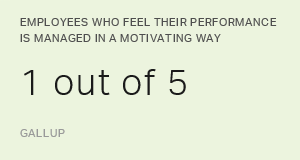Story Highlights
- Employee burnout is a consequence of the fast-paced modern workplace
- Organizations can and should alleviate burnout to improve productivity
- A supportive environment starts by focusing on these five factors
In this three-part series, we examine 15 workplace factors that correlate highly with employee burnout. First, we discussed the top five causes of burnout, then we looked at the next five factors to consider from a management perspective. In this final article, we explore the last five factors, which focus on what organizations can do to prevent burnout.
There is little doubt that employee burnout is a symptom of a modern workplace that is increasingly fast-paced, complex and demanding more of employees. Technology -- especially mobile technology -- has blurred the lines between home life and work life. Flexibility is now the watchword.
And yet, many employees feel overwhelmed by competing demands and conflicting expectations -- which ultimately leads to poorer health, stressed relationships outside of work and lower productivity.
Organizations are responsible for the well-being of their employees. Alleviating burnout is not only the right thing to do, it has multiple positive effects for an organization -- reducing turnover, reducing sick days and boosting productivity.
However, it's important to remember that employees want to work hard and be productive. Maximizing productivity while minimizing burnout may sound like a paradox, but Gallup's data suggest that organizations can accomplish both when they commit to addressing the root causes of burnout.
In terms of priorities, organizations should focus on manager training first. Our research consistently shows that no one has a more powerful influence on employee burnout than a direct manager.
Additionally, here are five things organizations can do to provide a supportive environment and reduce employee burnout:
1. Place performance expectations and metrics within employees' control.
Performance metrics tell employees and their managers how they're doing. Naturally, they also influence performance conversations and financial incentives. Employees who strongly agree their performance metrics are within their control are 55% less likely to experience burnout on a frequent basis.
When employees feel their work is being evaluated by metrics they can't control, anxiety results. Hard work feels pointless when external factors can easily obscure one's best effort. And metrics -- which should be a way to track success and show improvement -- become a chronic source of despair and frustration.
2. Reduce noise and interruptions.
Workplace studies have consistently shown that when employees are frequently interrupted the quantity and quality of their work suffers -- as well as their well-being. Of course, there's a place for collaboration in today's workplace, but organizations must provide quiet, comfortable workspaces where employees can easily immerse themselves in their work. Additionally, a culture that is flexible and allows employees to work where and when they want can help employees find their own ideal work conditions and help them to get into the flow of their work.
3. Design jobs to allow for autonomy.
Job autonomy means having flexibility and control over how work gets done. Employees are 43% less likely to experience high levels of burnout when they have a choice in what tasks to do, when to do them and how much time to spend on them. Although too much autonomy can create excessive ambiguity and also become a burnout risk, creating the proper job autonomy and flexibility should be part of every conversation about role design.
4. Audit your workspace lighting.
Good lighting is important to maximize productivity and promote positive emotions in the workplace. Natural lighting has been shown to promote calming, peaceful moods and reduce stress. A lack of natural lighting or the presence of poor, artificial lighting can cause negative moods and depression among employees. Every individual has their own preference for an environment that supports how they work best. Employers should find what's best for the majority of their team, while also providing alternatives for personal preferences.
5. Provide collaboration spaces that are inviting.
Employees who have a space that helps them connect with coworkers are 26% less likely to feel burnout on a frequent basis. When employees have to wait in line for conference rooms, huddle in private offices or work against background noise, collaboration becomes so difficult that employees avoid it. An inviting collaboration space should include features like room to move around, a whiteboard, teleconference capabilities and acoustics that allow everyone to be heard clearly.
As we've said earlier in this series, burnout is not inevitable. But its prevention requires both manager and organizational alignment: Employees are significantly less likely to experience burnout when they feel supported in their work and connected to their team and manager, but they also need to have clear and meaningful goals that are within their power to attain.
As with many aspects of life, when people are surrounded by a supportive team and environment, they naturally flourish and perform their best over the long term. That's beneficial for employees -- who enjoy healthier, happier lives. It's also beneficial for organizations who seek sustained, long-term productivity and growth.
Take a closer look at what Gallup recommends for sustainable productivity and growth:
- Download our position paper Re-Engineering Performance Management, to find out how to improve your management systems.
- Discover the best ways to prevent employee burnout.
- Discover how to optimize your workplace by creating a culture of well-being for all your employees.
Ryan Pendell contributed to this article.


